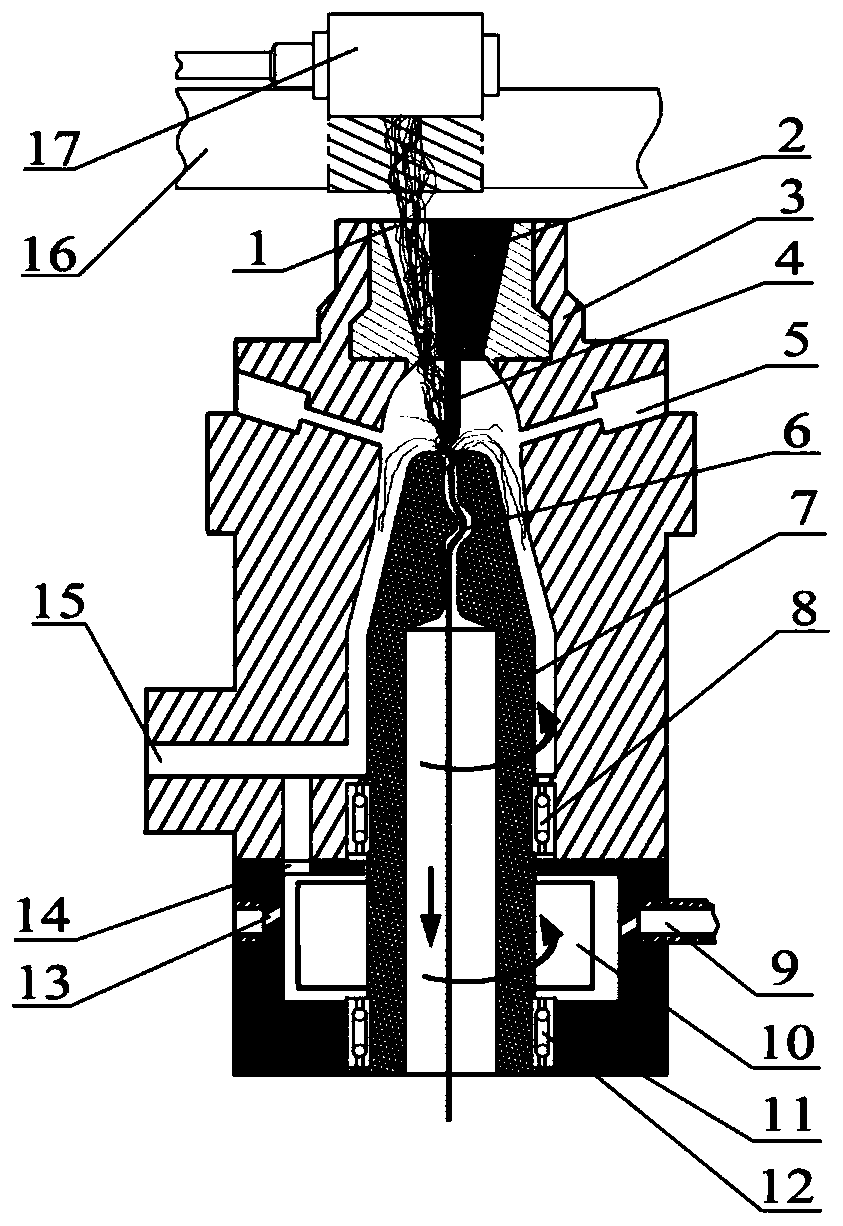[0003] However, production practice shows that the existing vortex spinning technology has obvious technical limitations
First of all, during the vortex spinning process, the fiber flow between the spindle and the front roller nip does not undergo twisting and twisting movement, the fiber head end is guided to the stationary spindle mouth by the outer wall of the guide pin on the fiber flow guide, and the fiber
tail end is free. The fibers inside the yarn body are arranged in parallel and the fibers in the outer layer are wrapped. The fibers in the yarn body lack internal and external transfer, and the cohesion is poor, resulting in the failure of short fibers with poor cohesion to form yarns.
Therefore, the suitable fiber length of vortex spinning is between 38-60 mm, and the range of raw materials is basically limited to short chemical fibers and medium-length fibers. Due to the quality of yarn formation, the competitiveness in the field of high-count yarn production is not strong.
Secondly, the yarn structure of
eddy current spinning is relatively loose, and the uniformity of long segments is good, but the strength is low, which limits the production of high-count yarns by
eddy current spinning.
Third, the head end of the fiber with a large curl cannot enter the stationary spindle mouth, and the entire fiber is directly blown away by the vortex air flow, resulting in that the fiber with a large curl (such as
wool) cannot be vortex spinning, and the vortex spinning can spin the fiber
raw material small range Chinese Patent Publication No. CN2835273, publication date 2006.11.08, the name of the invention is a new air-jet vortex spinning
nozzle device. The application provides a new type of air-jet vortex spinning
nozzle device. Control the
airflow power, reduce the unevenness of
fiber breakage, and improve the quality of fiber yarn to a certain extent; however, the application still cannot solve the problem of spinning high-count yarns of short fibers by
eddy current spinning machines
Chinese Patent Publication No. CN102108574, publication date 2012.04.25, the invention name is a method for producing hemp yarn by vortex spinning. This application case provides a method for producing hemp yarn by vortex spinning for the problem that hemp yarn cannot meet the requirements of high-count and high-density fabrics. The method is to improve the spinnability of
ramie fiber by performing a series of pretreatments on the
hemp fiber in the process before eddy current spinning, and then use the prepared
ramie fiber
raw material for conventional eddy current spinning, which improves the
hemp fiber to a certain extent. The quality of the eddy current yarn and the spinnable count of the
hemp fiber are improved; however, this method involves multiple pre-spinning processes such as the plucking
machine, the mixing opener, the vibrating cotton box, the lapping
machine, and the
carding machine, resulting in the use of The production process of high-quality
ramie fiber for eddy current spinning is too long and the cost is too high, which is not conducive to large-scale promotion and use
Chinese Patent Publication No. CN102691143A, publication date 2012.09.26, the name of the invention is a method for improving the yarn-forming performance of vortex spinning. The vortex spinning fiber strands are subjected to segmental heat and
humidity softening treatment, and the spinning method that instantly reduces the fiber stiffness greatly improves the fiber's easy control, easy torsion and twisting performance, and effectively improves the vortex spinning yarn performance
This application has indeed improved the strength of vortex spinning and the number of spinnable yarns to a certain extent, but there are still technical problems: 1) The
carding and twisting assisted vortex spinning device adopts the addition of a rotating mechanism in the stationary spindle, and the stationary spindle is still Keeping the static fixed structure leads to the fact that when the rotating mechanism rotates to assist the twist, when the twist is transmitted along the yarn sliver to the fiber strand, it is hindered by the friction of the yarn inlet of the stationary spindle, the twist cannot be effectively transmitted, and the twist assistance effect is poor.
2) The mechanical belt-type twist-assist rotating mechanism has limited rotation speed and poor twist-assist effect. It can only be effective for parallel twisting of two bundles of fibers, but has poor twist-assist effect for a
single fiber strand, and the improvement of
yarn strength is not obvious.
3) When the two strands of strands are twisted, the conformation of the two strands of twisting is formed, and the fibers inside each fiber strand are not fully internally and externally transferred. The traditional spinning device cannot solve the problem of effective internal and external transfer cohesion of a
single fiber strand, and cannot improve the fiber
utilization rate and
yarn strength of a
single strand Since the existing vortex spinning technology cannot effectively entangle and pre-twist the sliver fibers into yarn, for the elastic
wool fiber sliver with a high
crimp rate, the fiber tip cannot be inserted into the entrance of the stationary spindle at all during vortex spinning, resulting in Pure
wool sliver cannot be vortex-spun; 4) It is impossible to change the vortex spinning process of the existing vortex spinning device. When the fiber is wrapped into yarn, it only contacts with the static cone outer surface, and the wrapping is implemented only by the eddy current winding force. Winding, insufficient winding strength and fastness,
yarn strength needs to be further improved
 Login to View More
Login to View More  Login to View More
Login to View More 

